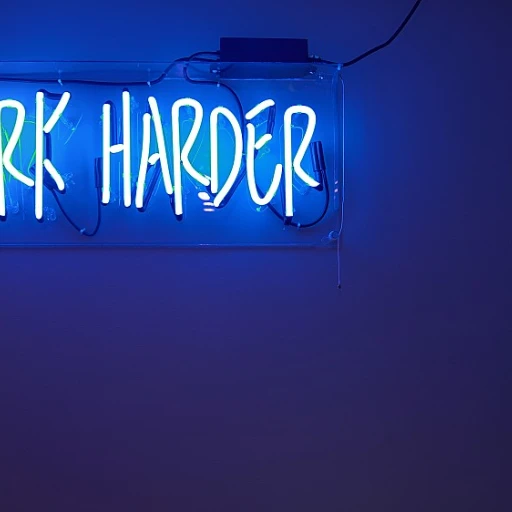
Understanding AI's Role in Setting Employee Goals
The Integration of AI in Establishing Employee Objectives
The application of artificial intelligence (AI) in human resources is transforming the approach to setting employee goals. Understanding AI's role offers an opportunity to streamline the process, allowing for tailor-made solutions that support both individual and organizational growth. With the integration of AI, companies can efficiently design goals that are specific, measurable, and aligned with the company's objectives.
AI's potential in goal setting is particularly apparent in the way it can analyze vast amounts of data to identify patterns and suggest performance goals that are both realistic and challenging. This can result in goals that not only align with an organization's strategic direction but also match each employee's skills and development needs.
A crucial advantage of using AI in employee goal setting lies in its ability to continuously track and assess employee progress. This enables HR professionals and managers to provide timely feedback and support for improvement, ensuring that goals remain relevant and attainable over time. Furthermore, leveraging AI can lead to more effective performance management by identifying areas where employees might need additional resources or training.
AI not only aids in goal setting and tracking but also fosters employee engagement. By providing personalized and achievable goals, employees are more likely to remain committed and motivated, leading to enhanced work satisfaction and retention rates.
Moreover, AI-powered goal setting promotes team cohesion by aligning individual goals with those of the broader team and organizational goals. This alignment enhances collaboration and fosters a sense of shared purpose among team members, ultimately leading to collective success.
For further insights on utilizing AI to enhance workforce capabilities and management strategies, you can explore how AI supports human and organizational development.
Examples of AI-Driven Employee Goals
Illustrative AI-Driven Goals for Optimal Performance
AI can significantly streamline the process of setting goals, ensuring they are tailored, actionable, and aligned with organizational targets. Explore different examples where AI-driven approaches have optimized employee performance, resulting in more productive and satisfied teams.- Improve Time Management: AI tools can analyze employees' time usage patterns, helping them set realistic goals for improving efficiency. For example, identifying specific times of day when employees are most productive can assist in scheduling work that requires high concentration accordingly, thus enhancing time management skills.
- Customer Service Enhancement: Utilizing AI to analyze feedback and performance data, customer service teams can set goals focused on reducing response times and improving customer satisfaction. This helps improve overall service quality, cultivating loyalty and positive client interactions.
- Professional Development Focus: By analyzing data on skills usage and workflow, AI can recommend personalized development goals. For instance, suggesting a series of online courses that align with the team's needs can help employees acquire new skills beneficial for long term career advancement.
- Problem Solving Objectives: By evaluating past performance reviews, AI can help establish goals aimed at enhancing problem-solving abilities. It might identify patterns in challenges faced and recommend strategies to improve problem-solving effectiveness, ultimately strengthening the team's overall capacity.
- Performance Goals Alignment: AI assists in aligning individual goals with broader business objectives. This involves analyzing company-wide performance data to ensure that individual goals contribute cumulatively toward the organization's targets, maximizing resources and efforts.
- Team Engagement Strategies: Through goal-setting systems powered by AI, HR management can track team engagement rates and recommend strategies to improve unity and collaboration. Goals aimed at fostering team spirit and collaboration can lead to a more cohesive work environment.
Benefits of AI in Goal Setting for HR
Advantages of Integrating AI into HR Goal Setting
Incorporating artificial intelligence in goal setting for human resource management offers a multifaceted range of benefits. The foresight of AI technology allows HR professionals to refine the practice of setting goals, ultimately enhancing employee performance and satisfaction.
- Precision in Goal Setting: AI tools provide precise and data-driven insights for crafting personalized performance goals tailored to individual employees. This ensures that goals are specific, measurable, achievable, relevant, and time-bound (SMART).
- Improved Employee Engagement: When employees see that their goals are clear and tailored to their skills and career aspirations, it can lead to boosted morale and employee engagement. It encourages them to take ownership of their progress and development.
- Real-Time Monitoring and Feedback: AI systems enable continuous monitoring of employee performance and offer real-time feedback. This facilitates timely adjustments in goal objectives and supports ongoing professional development.
- Efficient Performance Management: AI streamlines the performance review process, providing management with comprehensive data on team members' achievements relative to their targets. This improves decision-making in promotions and other HR activities.
- Scalable Solutions: AI-driven goal setting is particularly beneficial for larger organizations, where managing goals across departments and teams can become challenging. AI facilitates duplication of successful strategies across similar roles, ensuring consistency in performance standards.
In conclusion, the introduction of AI in goal setting not only offers a more nuanced approach to understanding and meeting employees' needs, but it also enhances overall performance management strategies. As human resources continue to adapt to technological advancements, leveraging AI can be instrumental in driving positive workplace outcomes and long-term development.
For a more detailed discussion on using AI in setting effective employee performance goals, explore our article on crafting effective employee performance goals.
Challenges and Considerations in Implementing AI for Employee Goals
Addressing the Complexities of AI in Goal Management
Implementing AI for setting employee goals can pose a few significant challenges and considerations for human resources to navigate. Understanding these complexities is vital for achieving seamless integration and successful management of goals within the organization. Data Privacy and Security One of the primary concerns when employing AI in goal management is the security and privacy of data. Employees' performance, development objectives, and progress data must be handled with the utmost confidentiality to maintain trust. Establishing robust data protection measures will help ensure the safe and secure handling of sensitive information. Employee Buy-in and Engagement Employees may be apprehensive about embracing AI-driven goal setting due to perceived threats to their autonomy or a lack of understanding of AI’s advantages. It is crucial to ensure superb communication and involve team members in the process, demonstrating the potential benefits and fostering a sense of ownership over their goals. Integration with Existing Systems Organizations often face obstacles in integrating AI tools with their current performance management systems. Seamless integration is necessary to achieve a cohesive approach to goal setting, management, and review processes. It might require dedicating time and resources to align AI tools with existing platforms effectively. Bias and Fairness AI algorithms, without proper supervision, can develop biases if trained on imperfect data sets. This can lead to unfair goal setting practices or discrepancies in performance evaluations. Regular assessments and updates of AI models will help mitigate biases, ensuring fair opportunities for professional development. Customization and Flexibility Not all employees or jobs have the same needs in terms of goals. AI systems must be adaptable to deliver specific and relevant goals catering to the diverse skills and roles within an organization. This flexibility aids in achieving long-term professional growth and fostering collaborative team environments. The implementation of AI in setting employee goals necessitates a thoughtful approach to overcome these challenges. With proper management, AI can significantly enhance employee performance and overall organizational objectives.AI Tools and Platforms for Employee Goal Management
Exploring AI Tools for Goal Management
In the evolving landscape of human resources, AI tools have become indispensable for managing employee goals effectively. These tools not only streamline the goal-setting process but also enhance the overall performance management system. Let's delve into some of the AI-driven platforms that are making waves in this domain.
AI Platforms Enhancing Goal Setting
Several AI platforms are designed to assist HR professionals in setting and tracking employee goals. These tools offer features that help in aligning individual objectives with organizational goals, ensuring that every team member is working towards a common purpose. Here are some examples:
- Performance Management Systems: These systems utilize AI to automate the tracking of employee performance goals, providing real-time feedback and insights. They help in identifying areas where employees need improvement and suggest specific development plans.
- Goal-Setting Software: AI-powered goal-setting software assists in creating SMART (Specific, Measurable, Achievable, Relevant, Time-bound) goals. These tools ensure that goals are clear and attainable, facilitating better performance reviews and employee engagement.
- AI-Driven Analytics: By analyzing data from various sources, AI tools provide insights into employee performance and progress. This helps HR teams in making informed decisions about professional development and long-term objectives.
Benefits of Using AI Tools
The integration of AI tools in goal management brings numerous benefits. They help in saving time by automating routine tasks, allowing HR professionals to focus on strategic initiatives. Additionally, these tools enhance employee engagement by providing personalized feedback and development opportunities. By leveraging AI, organizations can improve their overall performance management system, ensuring that all employees are aligned with the company's vision and objectives.
Considerations for Implementation
While AI tools offer significant advantages, it's crucial to consider potential challenges in their implementation. Organizations need to ensure that these tools are user-friendly and accessible to all team members. Moreover, continuous training and support are essential to maximize the benefits of AI in goal setting. By addressing these considerations, companies can effectively harness the power of AI to achieve their performance goals.
Future Trends in AI and Employee Goal Setting
Looking Ahead: Anticipating the Future of AI in Goal Management
The landscape of employee goal setting and management is poised for significant changes as AI technologies continue to evolve. Let's explore some trends and directions that organizations can expect in the near future, helping teams stay ahead and optimize goal achievement.- Advanced Personalization: AI is expected to become increasingly adept at tailoring performance goals to suit individual employee skills and their professional development needs. This level of personalization will empower employees to better focus on their specific objectives, resulting in more effective performance management.
- Ongoing Performance Feedback: Future AI tools will likely enhance employee engagement by providing real-time progress updates and customized performance reviews. Continuous feedback loops will help employees align their work with the organization's objectives, enabling them to make timely improvements.
- Predictive Analytics: Predictive models will help management by forecasting future performance trends based on historical data. This will allow HR teams to proactively address issues, identify high-potential team members, and adjust employees' goals to better fit long-term strategies.
- Seamless Integration: As AI solutions become more sophisticated, their integration with existing human resources management systems will improve. This will streamline goal setting and tracking processes, saving time for managers and employees alike.
- AI-Driven Employee Development: By analyzing the achievements and areas needing improvement, AI can assist in crafting targeted professional development plans, providing opportunities that align with both organizational goals and individual aspirations.
- Ethical Considerations: As AI plays a larger role in employee goal setting, organizations must remain vigilant about privacy and ethical use. Careful management and transparency will be crucial to maintaining trust and ensuring AI is used responsibly.












